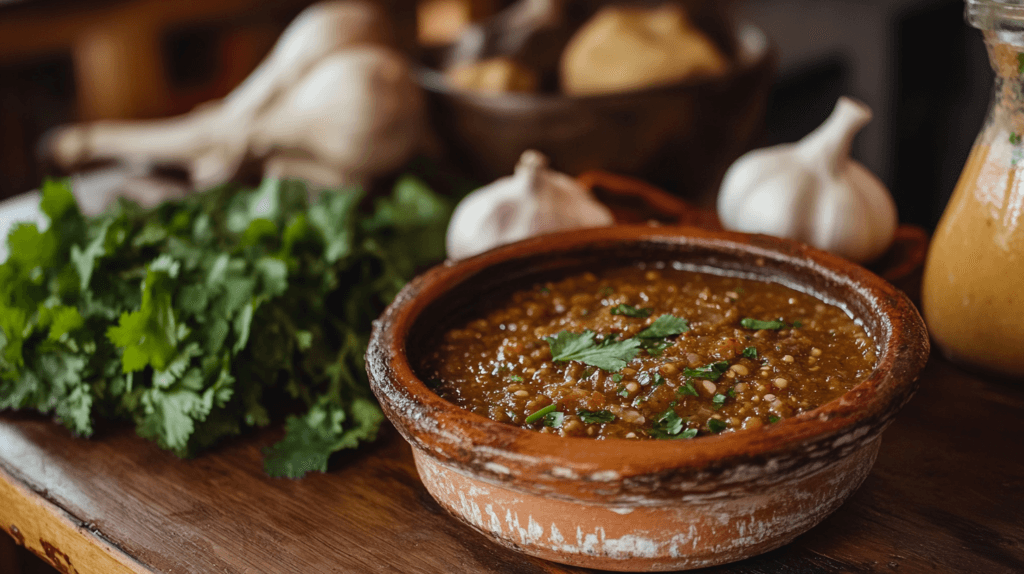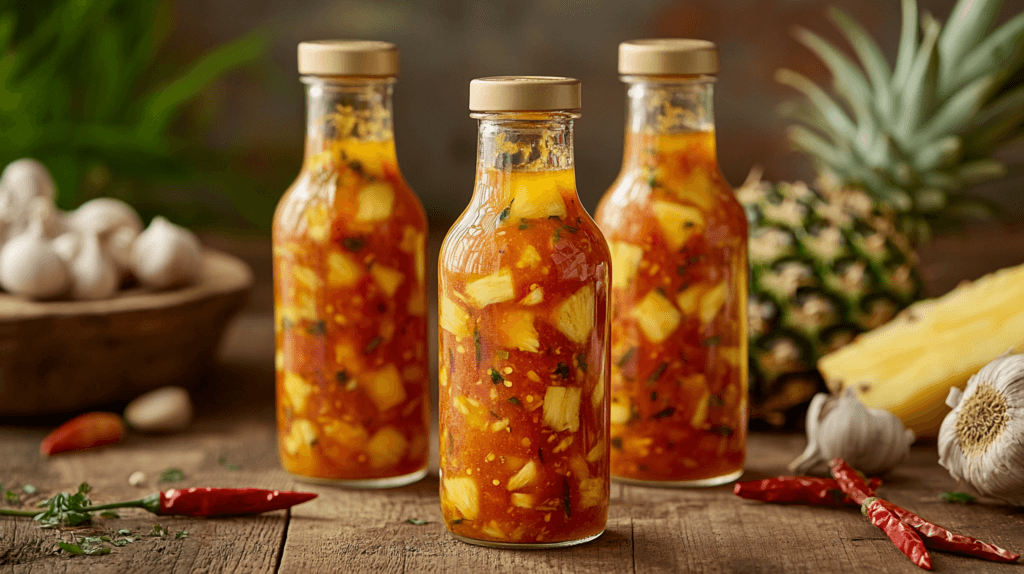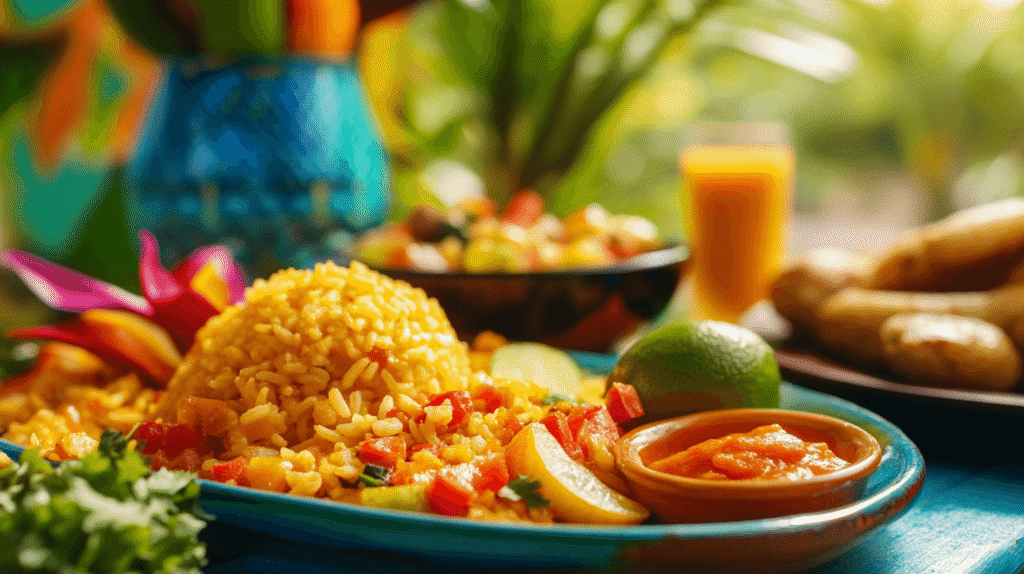Table of Contents
Puerto Rican cuisine is famous for its vibrant flavors, hearty dishes, and cultural fusion, but when it comes to spiciness, some people wonder: is Puerto Rican food spicy? The answer might surprise you! Unlike the fiery heat of some cuisines like Mexican or Indian, Puerto Rican food focuses on bold, savory, and aromatic flavors rather than intense heat.
In this article, we’ll explore the flavor profiles of Puerto Rican dishes, the key ingredients that define this unique cuisine, and how spiciness fits into the island’s culinary traditions. Whether you’re a fan of mild dishes or seeking a bit of heat, there’s something in Puerto Rican food for everyone. Let’s get started!
What Defines Spicy Food?
What is Spiciness?
Spiciness is often associated with the sensation of heat on the palate, which is caused by compounds like capsaicin, found in chili peppers. This fiery feeling can range from mild warmth to intense heat that leaves your mouth tingling. Spicy food is enjoyed across the globe, but the perception of what’s considered “spicy” varies widely between cultures.
How Spiciness Is Perceived Worldwide
In cuisines like Indian, Thai, or Mexican, chili peppers play a starring role, delivering bold levels of heat. In contrast, some cuisines, like Puerto Rican, focus more on flavor layers than overwhelming spice. For many, “spicy” isn’t just about heat but also about depth of flavor—balancing sweetness, acidity, and savoriness.
Spiciness also comes down to personal tolerance. What’s spicy to one person might taste mild to another. Now that we’ve clarified what spiciness means, let’s look at where Puerto Rican food falls on the spectrum.
Puerto Rican Cuisine Overview
A Quick Look at Puerto Rican Gastronomy
Puerto Rican food, known locally as “cocina criolla,” is a flavorful blend of influences from the island’s rich history. Indigenous Taíno, Spanish colonizers, and African slaves all contributed to shaping the unique culinary identity of Puerto Rico. The result is a cuisine that’s hearty, aromatic, and full of depth.
Staple ingredients like plantains, rice, beans, pork, and root vegetables are commonly used, complemented by seasonings that emphasize freshness and earthiness. Dishes are prepared with care to achieve a balance of flavors, ensuring no one element—whether salty, sweet, or spicy—overwhelms the others.
Cultural Influences on Puerto Rican Food
Puerto Rican food’s identity is rooted in cultural diversity. From the Taíno people, the island inherited ingredients like yucca, peppers, and annatto. The Spanish colonizers brought garlic, olive oil, and rice, which became essential elements in the cuisine. Meanwhile, the African influence introduced techniques like frying and contributed ingredients such as plantains and coconuts.
This fusion of cultures created a culinary tradition that prioritizes bold, flavorful combinations over intense heat. Puerto Rican cuisine has always been about creating comforting, satisfying meals for both family and community gatherings.
Is Puerto Rican Food Traditionally Spicy?
Traditional Flavor Profiles in Puerto Rican Cuisine
While Puerto Rican food is undeniably full of flavor, it is not traditionally spicy. The emphasis is on enhancing the natural taste of ingredients using aromatic seasonings rather than relying on heat. A typical Puerto Rican dish might include a mix of sweet, savory, tangy, and earthy flavors, but the spiciness level is usually mild to non-existent.
Instead of hot chili peppers, Puerto Rican cooking often incorporates ají dulce, a small pepper that resembles a hot chili but is sweet and mild. Another signature component is sofrito, a blend of garlic, onions, peppers, and herbs, which serves as the base for many dishes. The focus on flavor layering ensures that every bite is rich and complex without being overwhelmingly hot.
Common Spices and Seasonings Used
Puerto Rican food is defined by its use of spices and herbs that create depth without adding heat. Some key seasonings include:
- Adobo: A mix of garlic, oregano, turmeric, and black pepper, used to marinate meats and vegetables.
- Sazón: A seasoning blend featuring coriander, cumin, and annatto for a subtle smoky flavor and vibrant color.
- Culantro and cilantro: Fragrant herbs similar to parsley that add a fresh, herbal note to dishes.
- Garlic: Used generously in almost every recipe for a savory kick.
By blending these ingredients, Puerto Rican cooks craft meals that burst with flavor, proving that food doesn’t need to be spicy to be exciting.
Key Ingredients in Puerto Rican Cooking

Sofrito: The Flavor Base
If you want to understand Puerto Rican cuisine, start with sofrito. This aromatic base is the heart of many dishes, made by blending garlic, onions, peppers, tomatoes, and herbs like culantro. Sofrito adds a bold, earthy foundation to stews, rice dishes, and soups, creating a signature taste that’s unmistakably Puerto Rican.
Recao and Culantro vs. Cilantro
Culantro (known locally as recao) is a long-leaf herb with a pungent flavor often used alongside its milder cousin, cilantro. These herbs are staples in Puerto Rican cooking, providing a fragrant, herbal touch to dishes without adding any heat.
Achiote, Garlic, and Peppers
Another key ingredient is achiote (annatto), which gives dishes their distinct orange-red color and a slightly nutty flavor. Garlic, meanwhile, is used in abundance to create a savory punch, while peppers like ají dulce and bell peppers add sweetness and aroma rather than spice.
Comparison: Puerto Rican Food vs. Spicy Foods from Other Cultures
How Does Puerto Rican Cuisine Compare to Mexican or Indian Cuisines?
Puerto Rican food is often mistakenly thought to be spicy due to its use of peppers and bold seasonings, but it’s quite different from cuisines like Mexican or Indian, where heat is a defining characteristic.
In Mexican cuisine, dishes like tacos, enchiladas, and salsas feature spicy chilies like habaneros or jalapeños, delivering a significant kick. Similarly, Indian food frequently incorporates red chili powder, green chilies, or dried peppers to create the intense heat found in dishes like vindaloo or spicy curries.
In contrast, Puerto Rican cuisine uses peppers for flavor rather than heat. For example, ají dulce peppers, a staple in Puerto Rican cooking, look like fiery hot chilies but are sweet and mild. This sets Puerto Rican food apart by prioritizing a balance of flavors over spice.
Why Puerto Rican Food Isn’t Spicy by Default
The absence of extreme heat in Puerto Rican food reflects the island’s culinary philosophy: food should be approachable, flavorful, and comforting. This doesn’t mean Puerto Ricans don’t enjoy spice—it simply isn’t a central part of the cuisine. Heat is often added on the side in the form of hot sauces like pique, giving diners the choice to customize the spice level of their meal.
Puerto Rican Dishes That Are Mild
Arroz con Gandules
One of Puerto Rico’s most iconic dishes, arroz con gandules (rice with pigeon peas), is a perfect example of the island’s mild flavor profile. This dish combines seasoned rice, pigeon peas, and bits of pork or ham, flavored with sofrito and achiote. Despite its rich, bold taste, there’s no spiciness involved—just pure comfort food.
Mofongo
Another classic dish is mofongo, a mashed plantain dish often served with garlic and pork cracklings. Mofongo is savory and hearty, with a subtle garlicky kick but no heat. It’s a versatile dish that can be served as a side or topped with proteins like shrimp, chicken, or beef.
Asopao de Pollo
Puerto Rican asopao is a flavorful chicken and rice stew that’s warm, comforting, and mildly seasoned. Sofrito, olives, and herbs add depth to this dish without making it spicy. Asopao is especially popular during cooler months or as a comfort meal.
Puerto Rican Dishes with a Slight Kick
Pasteles and Alcapurrias
While Puerto Rican food is generally mild, some dishes offer a subtle kick. For instance, pasteles, which are similar to tamales, are made with a dough of grated plantains and yuca, filled with meat, and wrapped in banana leaves. The seasoning often includes hints of pepper, offering a slight, spicy undertone.
Similarly, alcapurrias, deep-fried fritters stuffed with ground beef or seafood, sometimes include spices or peppers for a mild touch of heat. However, the overall spiciness is still mild compared to foods from other cultures.
The Use of Ají Dulce
Ají dulce, or sweet peppers, are commonly used in Puerto Rican cooking for their unique ability to add flavor without heat. These peppers occasionally carry a slight, barely perceptible spiciness, giving certain dishes a gentle edge.
Do Puerto Ricans Like Spicy Food?
Spiciness Preferences in Puerto Rican Culture
Although Puerto Rican food isn’t traditionally spicy, many Puerto Ricans enjoy adding heat to their meals. Hot sauces like pique are a common condiment on tables across the island, allowing individuals to customize their meals to suit their taste. This approach keeps the food’s core flavors intact while satisfying those who crave a bit of spice.
Influence of Imported Hot Sauces
Globalization has also introduced Puerto Ricans to a variety of hot sauces from around the world. While traditional dishes remain mild, imported sauces like Sriracha or Mexican-style chili sauces have found a place in Puerto Rican households, reflecting a growing appreciation for spicier flavors.
Puerto Rican Hot Sauces

Popular Puerto Rican Hot Sauces
While Puerto Rican food is not inherently spicy, the island boasts some excellent hot sauces that bring heat to those who desire it. The most famous of these is Pique, a tangy and spicy sauce made with vinegar, hot peppers, garlic, and spices. Pique is a table staple, used to enhance dishes like mofongo, tostones, or grilled meats without overpowering the flavors.
Other popular hot sauces include:
- Pique Criollo: A traditional Puerto Rican-style hot sauce often made with homemade variations that include local peppers and herbs.
- Chilero: A slightly sweet, tangy hot sauce that balances heat with flavor.
Homemade Pique Recipes
In Puerto Rican homes, pique is often made fresh with local ingredients. A common recipe includes vinegar, hot peppers (like habanero or Scotch bonnet), garlic cloves, oregano, and sometimes pineapple chunks for a hint of sweetness. The mixture is left to steep for days or weeks, allowing the flavors to intensify.
The beauty of Puerto Rican hot sauces lies in their customizability—you can make them as mild or as spicy as you like, ensuring that they complement, rather than overshadow, the dish.
Balancing Flavor Over Heat
Why Puerto Rican Food Prioritizes Flavor
Puerto Rican cuisine is all about creating harmony in every bite. Instead of overwhelming heat, the focus is on balancing earthy, sweet, savory, and aromatic flavors. This makes the food approachable for a wide range of palates, from spice lovers to those who prefer milder tastes.
A key factor in this balance is the use of sofrito, which forms the backbone of many dishes. Sofrito combines ingredients like onions, garlic, peppers, and herbs to create a flavor base that’s bold yet not overpowering. The result is a cuisine that feels comforting and satisfying without relying on intense spice.
Layers of Flavor in Puerto Rican Cooking
Puerto Rican cooks achieve complexity by layering seasonings throughout the cooking process. For example:
- Proteins are marinated in adobo or sofrito before cooking.
- Rice dishes are cooked with sazón for added depth.
- Fresh herbs and mild peppers are added at the end for a burst of freshness.
This method ensures that every dish is rich, flavorful, and uniquely Puerto Rican.
How to Add Spice to Puerto Rican Dishes
Tips for Making Puerto Rican Food Spicier
If you enjoy spicy food, it’s easy to add heat to Puerto Rican dishes while maintaining their authentic flavors. Here are a few suggestions:
- Use Hot Peppers: Swap out ají dulce for hotter peppers like jalapeños, habaneros, or Scotch bonnets when making sofrito.
- Incorporate Pique: Add a few drops of Puerto Rican hot sauce to dishes like arroz con gandules or asopao to elevate the heat.
- Spice Up the Marinade: Enhance traditional adobo or sazón with crushed red pepper or chili powder.
- Serve with Spicy Sides: Pair mild dishes with spicy sides, like hot sauce-drizzled tostones or fried plantains.
Balancing Heat with Flavor
When adding spice, it’s important not to overshadow the dish’s core flavors. Use peppers and sauces sparingly to ensure that the traditional balance of sweetness, acidity, and savoriness is maintained.
Frequently Asked Questions (FAQs)
Why Isn’t Puerto Rican Food as Spicy as Mexican Food?
Puerto Rican cuisine has a different culinary philosophy than Mexican food. While Mexican food celebrates bold, fiery heat, Puerto Rican food emphasizes aromatic, balanced flavors using herbs and seasonings rather than chili peppers. For more insight into Puerto Rican cuisine, explore easy and flavorful Puerto Rican recipes to try at home.
Are All Peppers in Puerto Rican Food Hot?
No, many of the peppers used in Puerto Rican cooking, like ají dulce, are mild and sweet. These peppers add flavor without the heat, making them perfect for creating a well-rounded dish. Learn more about incorporating these flavors into dishes with our ultimate guide to soups and more using Dutch ovens.
Can You Ask for Extra Spice in Puerto Rican Restaurants?
Yes, many Puerto Rican restaurants offer hot sauces or spicy condiments on the side. If you enjoy heat, you can request extra spice to customize your meal. For those who like to experiment, consider pairing your meals with dishes inspired by calabacitas con queso for a wholesome experience.
What’s the Mildest Puerto Rican Dish?
Dishes like arroz con gandules or asopao de pollo are among the mildest. They’re flavorful but contain no heat, making them great options for those with sensitive palates.
What’s the Spiciest Puerto Rican Dish?
While Puerto Rican food isn’t typically spicy, dishes paired with homemade pique can pack a punch. Adding this hot sauce to mofongo or stews can create a spicy variation of a classic dish.
Conclusion
Puerto Rican food may not be traditionally spicy, but its rich flavors, fresh ingredients, and aromatic seasonings make it a culinary treasure. The cuisine prioritizes balance and depth, ensuring that every dish is satisfying and flavorful without relying on intense heat.
For spice enthusiasts, hot sauces like pique provide a customizable option to add heat while preserving the authentic taste of Puerto Rican dishes. Whether you prefer mild or spicy food, Puerto Rican cuisine offers something for everyone. So, the next time you sit down to enjoy a plate of arroz con gandules or mofongo, remember—it’s all about flavor, not fire.
Discover more ways to elevate your meals with step-by-step taco bowl recipes and embrace the diversity of Latin-inspired dishes.

